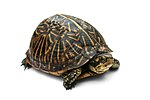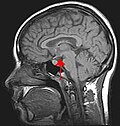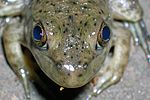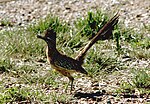Thermoregulation is the ability of an organism to keep its body temperature within certain boundaries, even when the surrounding temperature is very different...
55 KB (6,370 words) - 04:53, 10 June 2024
As in other mammals, human thermoregulation is an important aspect of homeostasis. In thermoregulation, body heat is generated mostly in the deep organs...
14 KB (1,839 words) - 13:01, 26 May 2024
Insect thermoregulation is the process whereby insects maintain body temperatures within certain boundaries. Insects have traditionally been considered...
16 KB (2,122 words) - 04:00, 19 June 2024
Pinniped (redirect from Thermoregulation in pinnipeds)
Pinnipeds (pronounced /ˈpɪnɪˌpɛdz/), commonly known as seals, are a widely distributed and diverse clade of carnivorous, fin-footed, semiaquatic, mostly...
106 KB (12,627 words) - 14:03, 21 July 2024
Rabbit (redirect from Thermoregulation in rabbits)
hares.[page needed] Rabbits' ears are an important structure to aid thermoregulation as well as in detecting predators due to the way the outer, middle...
81 KB (8,720 words) - 14:27, 19 July 2024
Bat (redirect from Thermoregulation in bats)
water loss. Water helps maintain their ionic balance in their blood, thermoregulation system, and removal of wastes and toxins from the body via urine. They...
168 KB (18,222 words) - 21:26, 21 July 2024
Mesotherm (category Thermoregulation)
coined to advocate for an intermediate status of non-avian dinosaur thermoregulation, between endotherms and ectotherms. A more technical definition was...
7 KB (756 words) - 02:31, 22 September 2023
Turtle (section Thermoregulation)
Turtles are reptiles of the order Testudines, characterized by a special shell developed mainly from their ribs. Modern turtles are divided into two major...
126 KB (13,108 words) - 10:15, 22 June 2024
Homeothermy (category Thermoregulation)
Homeothermy, homothermy or homoiothermy is thermoregulation that maintains a stable internal body temperature regardless of external influence. This internal...
9 KB (1,040 words) - 04:12, 26 June 2024
Mammal (section Thermoregulation)
in the spinal cord. The primary function of the fur of mammals is thermoregulation. Others include protection, sensory purposes, waterproofing, and camouflage...
224 KB (23,381 words) - 21:54, 24 July 2024
Newt (section Thermoregulation)
cutaneous water permeability, but promotes increased cutaneous blood flow. Thermoregulation, in combination with seasonal acclimation, describes the major mechanisms...
36 KB (3,836 words) - 01:38, 28 June 2024
keep the head clean when feeding, and also plays an important role in thermoregulation. Vultures have been observed to hunch their bodies and tuck in their...
25 KB (2,780 words) - 22:55, 26 June 2024
Black squirrel (section Thermoregulation)
that its frequency is the result of crypsis, and/or the result of thermoregulation. It has been theorized that non-melanistic gray squirrels have a concealment...
40 KB (4,516 words) - 02:41, 12 July 2024
chimpanzee, and other great apes. Loss of body hair in Homo links to the thermoregulation through perspiration heat dissipation required for activity in hot...
121 KB (13,485 words) - 22:59, 23 July 2024
depletion of electrolytes and bodily fluids Medications affecting thermoregulation Risk factors for heat exhaustion include: Wearing dark, padded, or...
24 KB (2,818 words) - 22:51, 25 July 2024
Lazarus M, Saper CB (September 2009). "Parallel preoptic pathways for thermoregulation". The Journal of Neuroscience. 29 (38): 11954–64. doi:10.1523/JNEUROSCI...
50 KB (4,962 words) - 20:52, 22 July 2024
Common ostrich (section Thermoregulation)
adaptations for thermoregulation, such as altering their feathers. Common ostriches display a feather fluffing behavior that aids them in thermoregulation by regulating...
122 KB (13,334 words) - 11:49, 20 July 2024
Viviparous lizard (section Thermoregulation)
Zootoca vivipara lives in very cold climates, yet participates in normal thermoregulation instead of thermoconformity. They have the largest range of all terrestrial...
30 KB (3,373 words) - 11:22, 18 July 2024
which regulates circadian rhythmicity and hormone production for thermoregulation. The hole that contains the eye is known as the pineal foramen or parietal...
14 KB (1,589 words) - 06:35, 5 July 2024
Shark (section Thermoregulation)
Sharks are a group of elasmobranch fish characterized by a cartilaginous skeleton, five to seven gill slits on the sides of the head, and pectoral fins...
143 KB (14,284 words) - 21:52, 25 July 2024
Nephila (section Thermoregulation)
Nephila is a genus of araneomorph spiders noted for the impressive webs they weave. Nephila consists of numerous species found in warmer regions around...
32 KB (3,989 words) - 14:30, 5 June 2024
Cathemerality (section Thermoregulation)
fraction of illuminated moon in relation to sunset and sunrise times. Thermoregulation has been said to be an adaptive response that enables cathemeral animals...
14 KB (1,596 words) - 07:43, 13 September 2023
Dimetrodon (section Thermoregulation)
used to stabilize its spine or to heat and cool its body as a form of thermoregulation. Some recent studies argue that the sail would have been ineffective...
81 KB (9,042 words) - 18:39, 27 June 2024
Bigeye thresher (section Thermoregulation)
The bigeye thresher (Alopias superciliosus) is a species of thresher shark, family Alopiidae, found in temperate and tropical oceans worldwide. Like the...
22 KB (2,665 words) - 22:09, 4 July 2024
Roadrunner (section Thermoregulation)
The roadrunners (genus Geococcyx), also known as chaparral birds or chaparral cocks, are two species of fast-running ground cuckoos with long tails and...
18 KB (1,711 words) - 16:07, 7 July 2024
suspend central homeostasis, allowing large fluctuations in respiration, thermoregulation and circulation which do not occur in any other modes of sleeping or...
70 KB (8,445 words) - 18:35, 15 July 2024
Kleptothermy (category Thermoregulation)
In biology, kleptothermy is any form of thermoregulation by which an animal shares in the metabolic thermogenesis of another animal. It may or may not...
17 KB (1,993 words) - 20:27, 7 November 2023
killed off much of the area's seagrass (and which would have also made thermoregulation difficult for the sloths, with their slow metabolism). Ground sloths...
50 KB (5,420 words) - 22:23, 3 June 2024
Pelagic thresher (section Thermoregulation)
The pelagic thresher (Alopias pelagicus) is a species of thresher shark, family Alopiidae; this group of sharks is characterized by the greatly elongated...
18 KB (2,249 words) - 21:20, 10 July 2024
Lizard (section Diurnality and thermoregulation)
out and bask in sunlight to gain enough heat to become fully active. Thermoregulation behavior can be beneficial in the short term for lizards as it allows...
69 KB (6,675 words) - 08:00, 14 July 2024
























